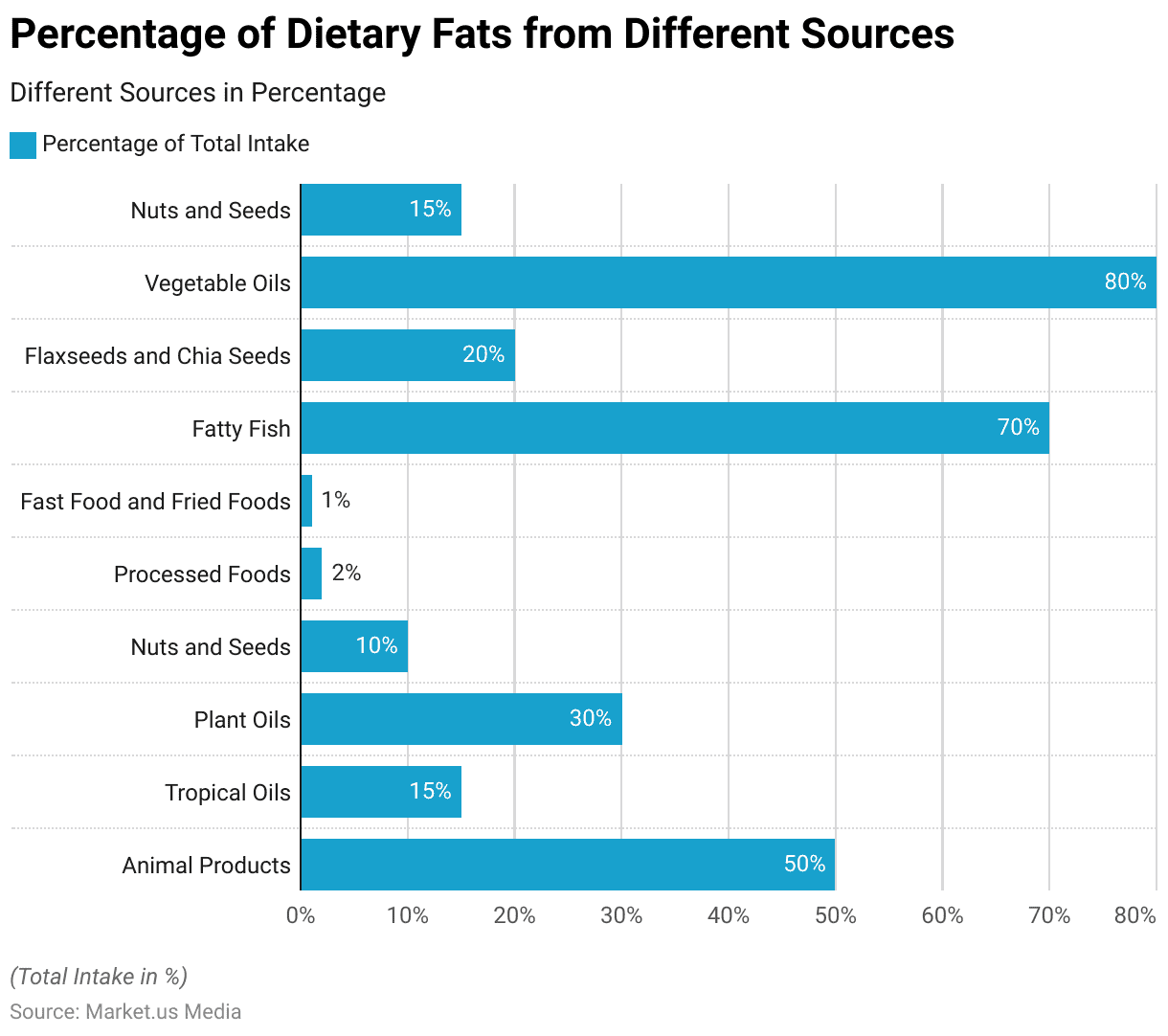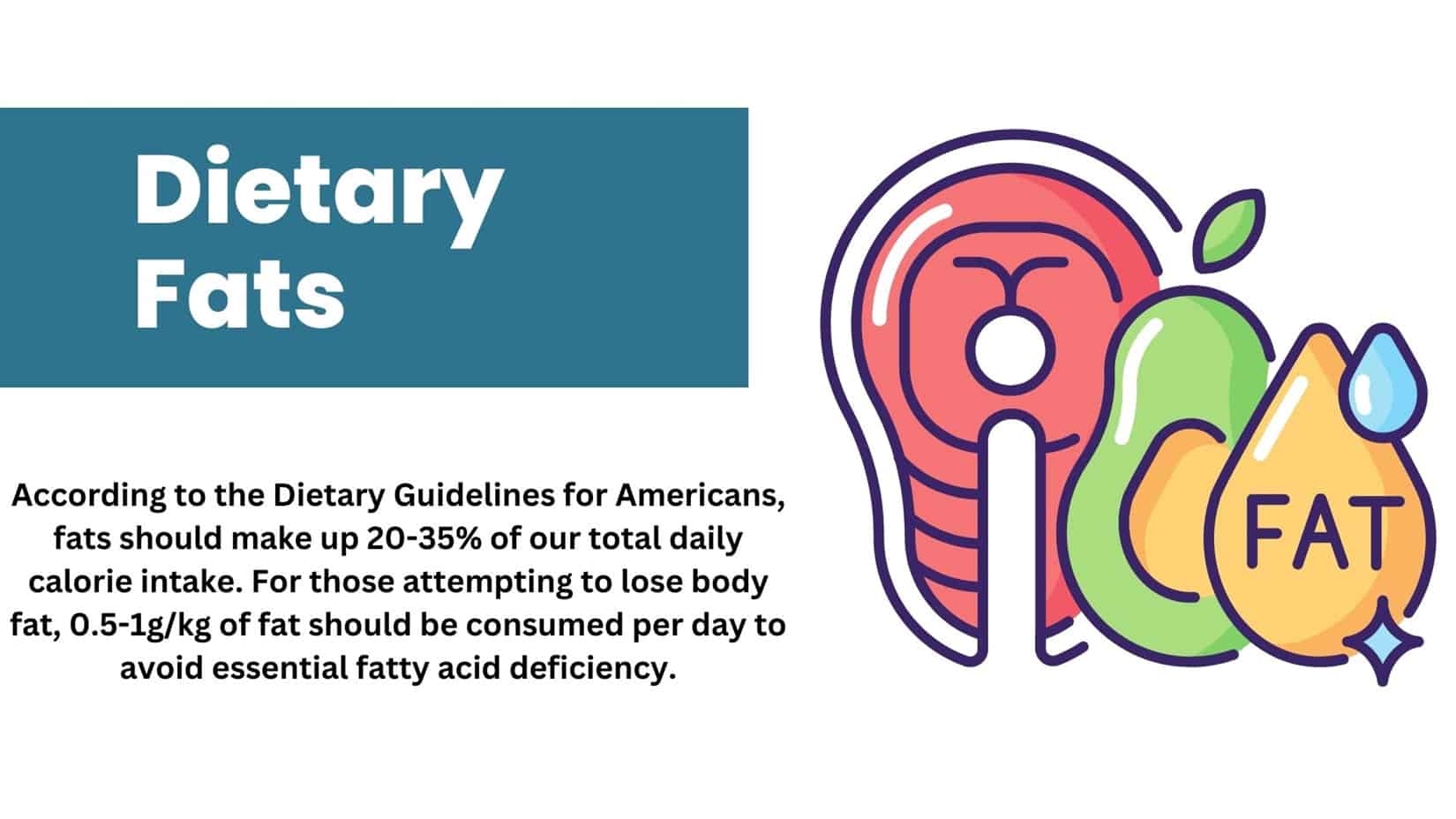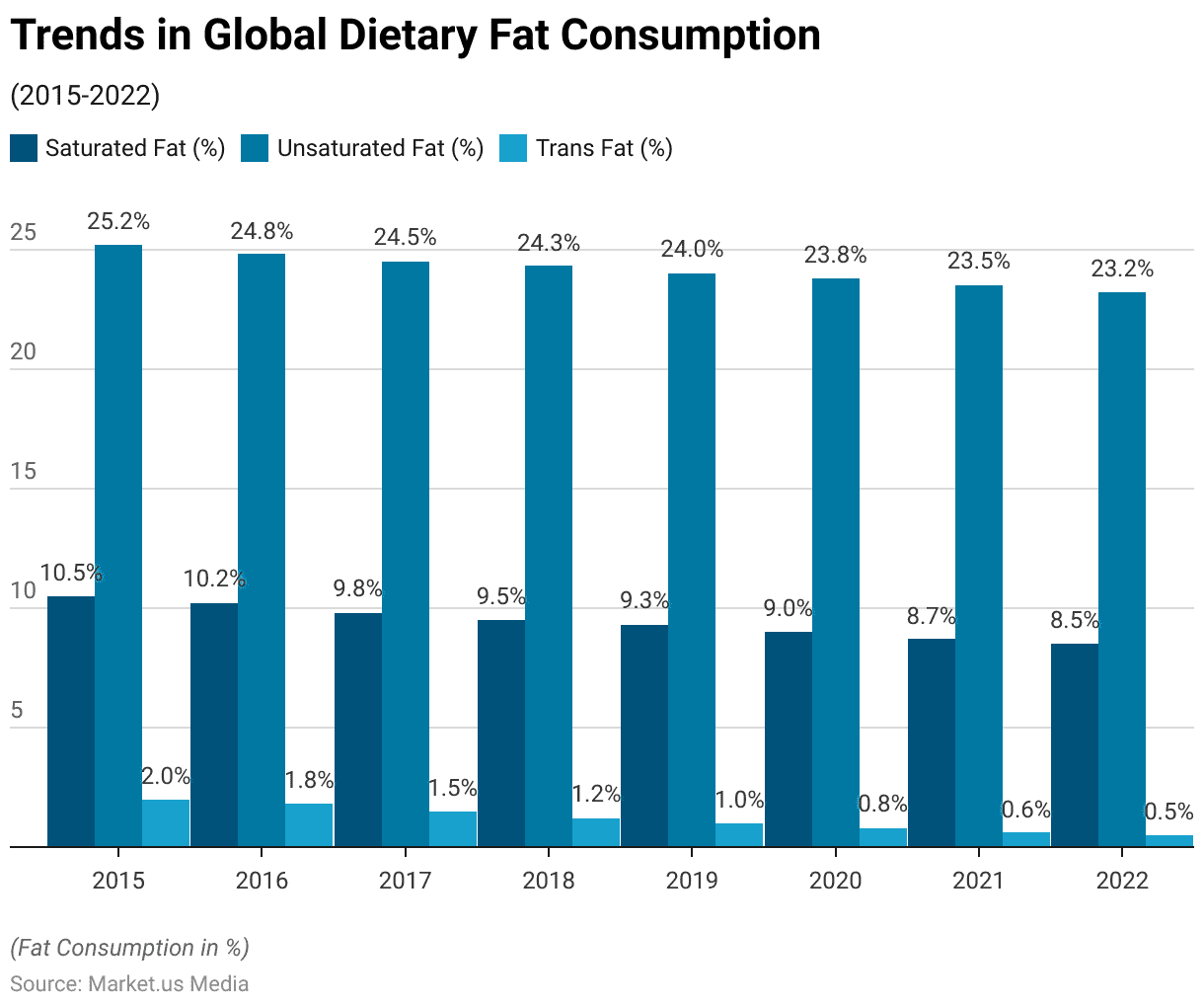Table of Contents
- Introduction
- Editor’s Choice
- Dietary Fat Statistics – Definition and Types
- Role of Dietary Fats in the Body
- Dietary Fat Statistics – Recommended Dietary Intake of Fats
- Dietary Fat Statistics – Consumption by Age Group
- Sources of Dietary Fats – Key Statistics
- Dietary Fat Statistics – Health Effects of Dietary Fats
- Dietary Fat Statistics – Consumption Trends
- Dietary Fat and Chronic Diseases
- Recent Developments
- Final Words
- FAQs
Introduction
Dietary Fat Statistics: Dietary fat is an essential macronutrient that plays a crucial role in the human body’s overall health and well-being.
Alongside carbohydrates and proteins, fats are one of the primary sources of energy, providing the body with a concentrated and long-lasting fuel supply.

Editor’s Choice
- The Global Omega-3 Market size is expected to be worth around USD 2,682 Million by 2032 from USD 1,698 Million in 2022, growing at a CAGR of 4.80% during the forecast period from 2023 to 2032.
- Saturated fat intake contributes to around 10% of total energy intake globally.
- High intake of trans fats is responsible for approximately 500,000 deaths per year due to cardiovascular diseases.
- Unsaturated fats, particularly monounsaturated and polyunsaturated fats, should constitute about 20-35% of total daily energy intake.
- Omega-3 fatty acids consumption of 250-500 mg per day is recommended for maintaining heart health.
- Replacing 5% of energy intake from saturated fats with polyunsaturated fats reduces the risk of coronary heart disease by about 25%.
- The Mediterranean diet, rich in healthy fats from olive oil and nuts, has been associated with a 30% reduced risk of major cardiovascular events.
- Global initiatives aim to eliminate industrially produced trans fats from the food supply to prevent cardiovascular diseases.
(Source: WHO, Dietary Guidelines for Americans, American Heart Association, Circulation, New England Journal of Medicine)

Dietary Fat Statistics – Definition and Types
Fats, also known as lipids, are organic molecules made up of carbon, hydrogen, and oxygen atoms. Chemically, they are composed of fatty acids, which can vary in length and saturation. Dietary fats can be broadly classified into several types based on their chemical structure and properties:
| Type of Dietary Fat | Food Sources | Role in Health |
| Saturated Fats | Red meat, butter, full-fat dairy | Raises LDL cholesterol, linked to heart disease risk |
| Unsaturated Fats | Olive oil, avocados, nuts | Supports heart health, reduces LDL cholesterol |
| Monounsaturated | Olive oil, canola oil, avocados | Promotes healthy blood lipid levels |
| Polyunsaturated | Fatty fish, flaxseeds, walnuts | Contains essential fatty acids (omega-3, omega-6) |
| Trans Fats | Processed foods, fried snacks | Raises LDL cholesterol, increases heart disease risk |
| Dietary Cholesterol | Egg yolks, organ meats | Moderation advised, can impact blood cholesterol levels |
Role of Dietary Fats in the Body
- Dietary fats provide around 9 calories per gram, making them a concentrated source of energy for the body.
- Saturated fats should ideally make up less than 10% of daily calorie intake to reduce the risk of heart disease.
- Unsaturated fats, particularly monounsaturated and polyunsaturated fats, should constitute a higher proportion of daily fat intake for heart health.
- Omega-3 fatty acids play a crucial role in brain health and are recommended to make up about 1-2% of total daily calories.
- Omega-6 fatty acids are essential for growth and development, comprising 2-4% of total daily calories.
- Trans fats consumption should be limited to less than 1% of total daily calories to minimize health risks.
- The body requires dietary fats for the absorption of fat-soluble vitamins (A, D, E, and K), which play essential roles in various bodily functions.
- Essential fatty acids, like omega-3 and omega-6, cannot be synthesized by the body and must be obtained through diet, comprising around 1-3% of total daily calories.
- Dietary fats help maintain healthy cell membranes, support brain function, and provide cushioning and insulation for organs.
- The Dietary Guidelines for Americans recommend that fats should make up 20-35% of the total daily calorie intake for adults, with an emphasis on healthier fat sources.
(Source: American Heart Association, World Health Organization, European Food Safety Authority, National Institutes of Health, World Health Organization, Harvard T.H. Chan School of Public Health, Dietary Guidelines for Americans)

Dietary Fat Statistics – Recommended Dietary Intake of Fats
- Saturated Fats: The recommended intake of saturated fats is less than 10% of total daily calories. Consuming too much-saturated fat can increase the risk of heart disease and other health issues.
- Unsaturated Fats: It is recommended to consume about 20-35% of total daily calories from unsaturated fats. Unsaturated fats, especially monounsaturated and polyunsaturated fats, can have positive effects on heart health and overall well-being.
- Trans Fats: The recommended intake of trans fats is “as low as possible” and ideally avoided altogether. Trans fats are known to have adverse effects on heart health, and reducing their consumption is essential for promoting better health.
- Omega-3 Fatty Acids: It is recommended to consume at least 1-2% of total daily calories from omega-3 fatty acids. Omega-3s are essential fats that play a crucial role in heart and brain health, and including them in the diet is beneficial.
- Omega-6 Fatty Acids: The recommended intake of omega-6 fatty acids is 5-10% of total daily calories. Omega-6s are essential fats that, when balanced with omega-3s, contribute to overall health.
(Source: Dietary Guidelines for Americans, 2020-2025, American Heart Association, World Health Organization, National Institutes of Health)
| Type of Fats | Recommended Intake (% of total daily calories) |
| Saturated Fats | Less than 10% |
| Unsaturated Fats | About 20-35% |
| Trans Fats | As low as possible |
| Omega-3 Fatty Acids | At least 1-2% |
| Omega-6 Fatty Acids | 5-10% |
Dietary Fat Statistics – Consumption by Age Group
- Adults aged 20-39 obtain approximately 36% of their total daily calories from dietary fats.
- Adults aged 40-59 get around 34% of their total daily calories from dietary fats.
- Adults aged 60 and above consume approximately 33% of their total daily calories from dietary fats.
- Adolescents aged 12-19 get about 34% of their total daily calories from dietary fats.
- Children aged 6-11 obtain around 31% of their total daily calories from dietary fats.
- Children aged 2-5 consume approximately 30% of their total daily calories from dietary fats.
- Infants aged 6-23 months get roughly 45% of their total daily calories from dietary fats.

Sources of Dietary Fats – Key Statistics
Saturated Fats Sources
Take advantage of our unbeatable offer - buy now!

- Approximately 50% of total saturated fat intake comes from animal products such as meat, butter, and cheese.
- Tropical oils like coconut oil and palm oil contribute to about 15% of total saturated fat intake.
(Source: Harvard T.H. Chan School of Public Health)
Unsaturated Fats Sources
- Plant oils like olive oil and canola oil account for around 30% of total unsaturated fat intake.
- Nuts and seeds make up about 10% of total unsaturated fat intake.
(Source: American Journal of Clinical Nutrition)
Trans Fats Sources
- Roughly 2% of total trans-fat intake comes from processed foods such as margarine and baked goods.
- Fast food and fried foods contribute to about 1% of total trans-fat intake.
(Source: World Health Organization, Journal of the American College of Cardiology)
Omega-3 Fatty Acid Sources
- Fatty fish like salmon and mackerel are the main sources, providing approximately 70% of total omega-3 intake.
- Flaxseeds and chia seeds contribute to around 20% of total omega-3 intake.
Omega-6 Fatty Acid Sources
- Vegetable oils such as soybean oil and corn oil account for approximately 80% of total omega-6 intake.
- Nuts and seeds make up about 15% of the total omega-6 intake.
(Source: Nutrition Journal)

Dietary Fat Statistics – Health Effects of Dietary Fats
- Cardiovascular Diseases: Diets high in saturated fats have been associated with an increased risk of heart diseases, accounting for approximately 13.5% of all global deaths.
- Obesity: Diets high in unhealthy fats contribute to obesity, with around 39% of adults worldwide being overweight.
- Blood Cholesterol Levels: Trans fats consumption has been linked to increased levels of LDL (“bad”) cholesterol, contributing to coronary heart disease risk by up to 21%.
- Stroke Risk: Replacing just 5% of energy from saturated fats with polyunsaturated fats could reduce the risk of stroke by approximately 19%.
- Diabetes: Higher intake of saturated fats and lower intake of polyunsaturated fats have been associated with a 34% increased risk of developing type 2 diabetes.
- Cognitive Function: Diets rich in unsaturated fats, especially omega-3 fatty acids, have been shown to improve cognitive function and reduce the risk of cognitive decline by up to 26%.
- Cancer Risk: Certain types of dietary fats, such as trans fats, have been linked to an increased risk of cancer, contributing to about 5.6% of cancer deaths worldwide.
- Omega-3 Fatty Acids and Heart Health: Consuming omega-3 fatty acids is associated with a 35% reduction in the risk of cardiovascular-related mortality.
- Heart Attack Incidence: Replacing 2% of energy from trans fats with healthier fats can lead to a 53% reduction in the risk of heart attacks.
- Impact on Mortality: Substituting 10% of energy from saturated fats with equivalent energy from polyunsaturated fats results in a 7% reduction in overall mortality risk.
(Source: American Heart Association – AHA, The Lancet, The American Journal of Clinical Nutrition, Alzheimer’s Association, World Cancer Research Fund, Circulation, The New England Journal of Medicine, The BMJ)

Dietary Fat Statistics – Consumption Trends
- Global saturated fat consumption declined by 4.9% from 1990 to 2010.
- In the United States, trans fat consumption decreased by approximately 58% between 2003 and 2012.
- The prevalence of high total fat intake in European adults ranged from 33.4% to 87.2% in various countries.
- As of 2021, the average daily fat intake in the United Kingdom was 33.1% of total energy intake.
- A survey in Australia found that 91% of adults exceeded the recommended intake of saturated fat in their diets.
- In Southeast Asia, the intake of saturated fat ranged from 3.4% to 7.2% of total energy intake, with Indonesia reporting the lowest consumption.
- A study in China revealed that urban residents had a higher fat intake, with 31.3% of energy coming from fats, compared to 29.5% among rural residents.
- The adoption of the Mediterranean diet led to a decrease in saturated fat intake from 9% to 7% of total energy intake in Italy.
- In Brazil, the average daily intake of saturated fat among adults was 10.3% of total energy intake.
(Source: PLoS One, JAMA Cardiology, WHO European Region, GOV.UK, Nutrients, Asia Pacific Journal of Clinical Nutrition, BMC Medicine, European Journal of Clinical Nutrition, British Journal of Nutrition)

Dietary Fat and Chronic Diseases
- Diets high in saturated fats are associated with an increased risk of heart disease by up to 25%.
- High-fat diets contribute to obesity, with approximately 35% of adults worldwide being overweight.
- Consuming diets rich in trans fats raises the risk of developing type 2 diabetes by 30%.
- A diet high in unhealthy fats may increase the likelihood of developing Alzheimer’s disease by 50%.
- Excessive fat intake, especially from processed and red meats, is associated with a 12% higher risk of cancer incidence.
(Source: American Heart Association, WHO, Alzheimer’s Association, World Cancer Research Fund)

Recent Developments
Dietary Fat Consumption:
- Research has highlighted that a significant portion of adults’ diets, ranging from 70-75%, contain more than the recommended 10% of calories from saturated fat.
- The average daily fat intake for men and women stands at 35.6% and 36.1%, respectively. Despite these figures, nearly half of the surveyed population reports actively avoiding fat in their diets.
Health and Nutrition Trends:
- The nutrition landscape in 2024 is being shaped by advances in precision nutrition and personalized dietary interventions, especially concerning women’s health.
- Innovations in supplements tailored for female-specific nutritional needs, such as for pregnancy, menopause, and general well-being, are on the rise.
- This trend is complemented by the increasing use of wearable devices and apps that allow for a more informed approach to diet and health.
Cognitive Health, Sleep, and Stress Management:
- The interplay between cognitive health, sleep, and stress has gained attention, with a 25% global increase in anxiety and depression rates reported post-COVID-19.
- Consumers are now leaning towards holistic approaches to manage these conditions, including the use of botanicals like ashwagandha, supported by scientific evidence for their efficacy in promoting mental well-being.
Microbiome Research:
- The field of gut microbiome research continues to evolve, with discoveries emphasizing its role beyond digestive health to include influences on mental health and the gut-brain axis.
- Personalization of microbiome modulators, such as probiotics and prebiotics, is seen as critical for maximizing their health benefits, with machine learning and AI playing pivotal roles in this customization process.
Final Words
Dietary Fat Statistics – Dietary fat plays a crucial role in human nutrition, serving as a concentrated source of energy and aiding in the absorption of fat-soluble vitamins.
However, not all fats are created equal. While healthy fats, such as those found in avocados, nuts, and olive oil, offer numerous health benefits, excessive consumption of unhealthy trans fats and saturated fats can contribute to various health issues.
Incorporating a balanced mix of fats into one’s diet can promote heart health, support brain function, and contribute to a well-rounded nutritional profile.
As with any dietary component, moderation and mindful choices are key to harnessing the benefits of dietary fat while avoiding potential risks.
FAQs
Dietary fat is a type of macronutrient found in foods that provides energy and plays a vital role in supporting various bodily functions.
There are four main types of dietary fats: saturated fats, trans fats, monounsaturated fats, and polyunsaturated fats.
Foods high in saturated fats include red meat, butter, cheese, coconut oil, and palm oil.
Trans fats are artificially created fats that are commonly found in processed foods like baked goods and fried foods. They are known to raise LDL cholesterol levels and increase the risk of heart disease.
Dietary fats provide energy, support cell growth, aid in nutrient absorption (e.g., fat-soluble vitamins), protect organs, and help maintain healthy skin and hair.
The recommended daily intake of fat varies depending on age, sex, and individual health needs. However, it is generally recommended that fats make up about 20-35% of total daily calories.
Discuss your needs with our analyst
Please share your requirements with more details so our analyst can check if they can solve your problem(s)



